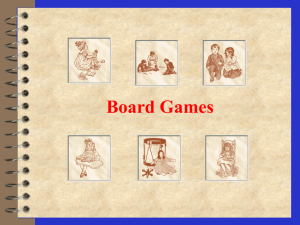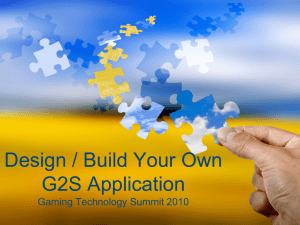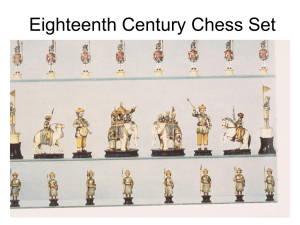What is in a Game
advertisement
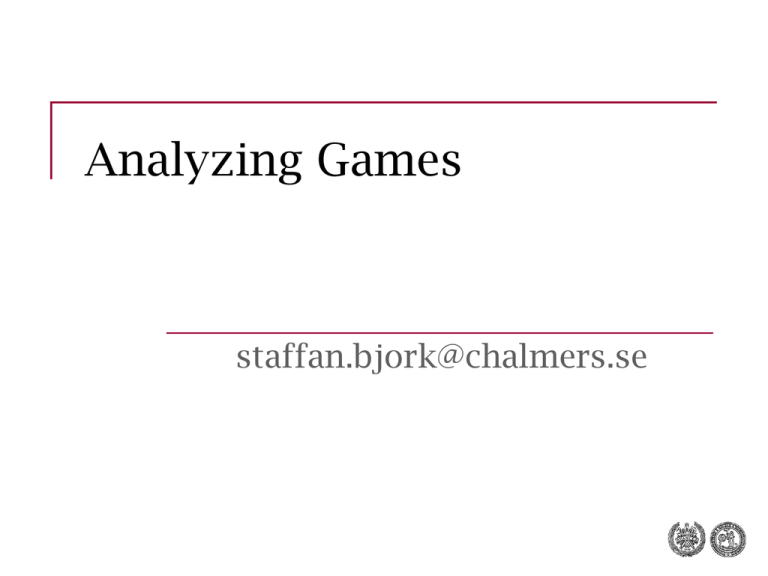
Analyzing Games staffan.bjork@chalmers.se Structure of today’s lecture Motives for analyzing games General components of games Example from course book Example from Rules of Play An Activity-centric Approach With a structural focus Component Framework Presentation of Assignment 2 Reasons to analyze games Common structures Identify differences What works and what doesn’t work Prove hypothesis Deeper understanding of what games are Find or isolate problems Learn how a game works How it affects people How one can reproduce the effects Example: Quake and Go Fish Example: Quake and Go Fish Comparison to understand what games consist of Identify formal and dramatic elements Find a definition Closed, formal system Engages players in structured conflict Resolves in an unequal outcome Example: Quake and Go Fish, cont. Formal elements Players Objectives Procedures Rules Resources Conflict Boundaries Outcome Dramatic elements Challenge Play Premise Character Story Ways of studying games Structural – what does a game consist of? Interaction design – gameplay Operational processes - programming Problem solving – game theory Events and stories – narratology (more later lecture) Operational - how is a game played? What do players do when playing? Self-organization Social structures Extra-game motivation and consequences Ways of studying games, cont. Motivational - Why is a game played? Learning Immersion (Catharsis?) Social activity Creativity Player-focused - Who plays games? What player groups exist? When, why and how do people start playing games? When, why and how do people stop playing games? Ways of studying games, cont. Ways of studying games, cont. Games Ways of studying games, cont. Gamers Ways of studying games, cont. Gaming Ways of studying games, cont. Gaming Gamers Games Focus for this course Gaming Specifically game mechanics i.e. rule constructs Games Perspective of games in Rules of Play Game Design Schemas Core Concepts Rules Play Culture Meaningful Play Design Systems Interactivity The Magic Circle Games as rules, play or culture Types of Rules From Rules of Play Operational Rules Underlying formal structures Consequences and emergent features Implicit Rules Good sportsmanship Let other player “take back” a move Explain options and consequences Instantiation Level Constitutive Rules “Rules of Play” Written rules in traditional games Additional distinctions Game rules Gaming rules Explicitly changed rules House Rules Rules of Play example: Tic-TacToe Rules of Play example: Tic-TacToe Operational Rules Constitutive Rules X starts; alternate placing one symbol on free space; wins if three-in-a-row; draw if no free spaces Unwinnable if both players play optimally Implicit Rules Not tell other player constitutive rules? An Activity-Centric Approach to Game Research Grounded in Interaction Design Design area focused on interaction Describes interaction in games Focused upon artifact (game) but aimed at interaction (gaming) IT a powerful enabler Game Design Patterns Game Ontology Projects Describes interaction facilitators Component framework Used in assignment 2 The Component Framework Component Framework An activity-based model of game interaction Includes traditional concepts used to describe games Lays out how games are constructed Player, element, rule, goal, etc. Focus on game mechanical aspects Describe, analyze and compare games Game state assumed Playing the game is making changes in the game state! (and getting and refining information about the game state) Component Framework Holistic How the activity of playing the game is divided Game Instance: whole lifetime of the game Game Session: the whole activity of a player playing one game Play Session: a player actively playing the game Extra-game activities: activities related to game Set-up/down: preparatory and end game activities Game Instance Setting up the game All the actions of all the players participating in the game Ending the game and determination of the final outcome Activities required to restore or clear the game state after playing the game Rules used in an instance are the gaming rules Contrasted to the generic game rules Game Instance: A typical Chess game Two players decide to play Chess Beginning of a game instance of Chess Setting up the initial board and determining who is playing which side The actions of both of the players Determining the outcome and possible impact outside this game instance (tournament etc.) Clearing the game state Players put the board and pieces away Game Session Complete activity of one player participating in a game instance Player specific Chess game instance has two game sessions Usually game instance and game session coincide in time Game Session: Examples Asteroids Player puts in coins: set-up Plays the game until loses all lives: play session Enters initials to the highscore list: set-down Massively Multiplayer Online Role-Playing Game Player creates a character: set-up Logs in to play every now and then: several play sessions Finally decides to stop playing the game and removes the character: setdown Play Session The length of time one player is actively playing the game One game session can consist of many play sessions But in many games game and play sessions coincide Play session consists of all the player actions during the session Can be described as a sequence of changes in modes of play Play Session: Examples Asteroids Strategy games Player can save the progress, close the game and come back later Many player controlled play sessions Play-by-mail Chess The same as the game session for one player Player opens the envelope Makes his move by writing it on a piece of paper Sends the move sheet to the other player World of Warcraft Doing one raid Set-up Session Game Instance Set-up the initial game state Invite players Allow the game to start Game Session The player or the facilitator configures the initial starting position in the game The player registers to the game Play Session Prepare the play session Log in the game, select profile etc. Set-down Session Game Instance Declare that the game has ended Determine the final outcome Return the initial game state if need be Usually the facilitator takes care of this Game Session The player’s initial state restored or removed altogether Take care of possible meta-game effects Play Session Save the current state for further play sessions … or end the game session Extra-game activities Activities related to the game but do not have a direct effect on the game state Planning activities Creating strategies Modifications to the game Skins in Sims Game mods Acquiring equipment or game elements Create new games! Buying a booster pack for Magic: the Gathering Using the game for other purposes Creating movies, stories, or stunt shows Boundary Components Limit the player activities by allowing certain actions and making some activities more rewarding. Rules: dictate how everything works! Modes of Play: different phases of the game Goals and subgoals: motivation for playing the game in certain ways Rules Limit player actions Describe and lay out the boundaries of the game Govern how the other components of the framework are instantiated Meta-components Static or dynamic Chess vs. Nomic Explicit or implicit Rules explicitly known to the player Rules “hidden” in the game system Modes of Play Different phases or sections of the game where Actions are different, or Goals are different, or Interface is different, or Players are different Changes between modes governed by rules Modes can have sub-modes Modes of Play: Examples Taking turns in Chess Inventory mode Many adventure and RPG computer games have a different mode for manipulating the inventory Different phases in board games While the other player makes his move the player cannot move his pieces Diplomacy has diplomatic, action and turn resolution phases Eating the power pill in PacMan Possible to hunt the ghosts! Goals and subgoals Define the game states the player tries to achieve Motivation for playing the game Achievement Almost always nested hierarchies or networks Subgoals of subgoals of subgoals etc. Can be player defined during the play SimCity and Sims Goals and subgoals: Examples Pac-Man Get as high score as possible Complete the level Eat a dot Eat a power pill Eat as many ghosts as possible during the effect of the pill Temporal Components Describe the flow of the game play and define the changes in the game state Actions: what the player can do Events: what are the game state changes Closures: meaningful game state changes End conditions: determine changes of mode of play and closures Evaluation functions: determine the outcome of an end condition Actions What the player can do to change the game state Explicit or implicit Directly available through controller or the UI “Hidden” in the game system Text adventures The way to change the game state Not the actual physical movement of pressing the button Related to the interface Actions: Examples Pac-Man Asteroids Movement up, down, left and right using the joystick Steer left or right Use the rocket to move the ship Shoot bullets Space invaders Move left or right Shoot a bullet Events Changes in the game state Perceivable to the players Change of mode of play, closures Consequences of the actions Own actions Other player actions Game system generated Computer controlled opponents Gravitation, inertia and other automatic events Events: Examples Pac-Man Pac-Man starts to move the direction Eats a pill The ghosts move, regenerate etc. Tetris New block appears The block starts to fall down The block gets stuck Full rows are removed The game ends Closures Quantifiable and meaningful player experiences normally associated with game state changes Associated with goals Reaching a goal (winning condition) Failing to reach a goal or losing the game (loss condition) Occur during gameplay (while goals are part of the game) Not necessarily defined as particular game states Borderline between first and second order game design concepts, may be player defined Normally deeply nested Subclosures of subclosures of subclosures Closures: Examples Pac-Man Eating a pill Eating a power pill Eating a ghost Eating all the ghosts Finishing a level Losing a life Losing all lives Getting the high score Etc. Civilization Founding a city Completing a building/unit Completing research Winning a fight Discovering a hut/nation Eliminating an opponent Traveling to a star Etc. End Conditions and Evaluation Functions End condition is a game state requirement for Switching the mode of play Completion of a closure End of a game instance, game or play session Always associated with an evaluation function Together define win and loss conditions Evaluation function defines what is the outcome of the end condition End Conditions and Evaluation Functions: Examples Pac-Man Eating a pill: Pac-Man moves over the pill -> more points Finishing a level: All pills eaten -> progress to next level Etc. Chess Check mate opponent’s king: the king cannot move > the other player wins Structural Components Define the parts of the game which are manipulated by the players and the game system Interface: provides players information about the game state and possible actions Game Elements: components that contain the game state Players: entities that try to achieve their own goals within the game Game Facilitator: synchronizes the game state Interface Provides the player information The game state What actions are available Provides the player access to the actions What the player has to physically do to perform the action Can help to express the theme of the game Audio-visual style Interface: Examples Chess: The board laid out as 8X8 grids The pieces on the grids define the game state The player can move the piece by picking it up and putting it down Pac-Man Joystick for controlling the movement of the Pac-Man The level is shown on the screen Audio effects related to events Game Elements Physical and logical components that contain the game state Can be manipulated by player actions and game events Usually have attribute values that define their abilities Type Who controls What does it look like Etc. Game Elements: Examples Elements that define the game world Chess board The landscape in a strategy game The geography of a fantasy role-playing game Elements that personify the player Pac-Man Asteroids ship Player’s avatar in the RPG Elements that are controlled by the player Units in a strategy game Chess pieces Players Representation of entities trying to achieve goals Change the game state through actions Can be human players or computer controlled Can compete against each other Can cooperate with other players Different ways of analysis Ghosts in Pac-Man as other players Tetris as a two player game? Players: Examples Pac-Man The player controls the yellow Pac-Man Avoids the ghosts Computer controls the ghosts Try to catch Pac-Man Similarities to Tag Chess The white and black player try to eliminate each other MMORPGs Thousands of players represented by avatars in the game world Facilitator Takes care of setting up the game Synchronizes the game state Can be players themselves Children games Ultimate arbitrator of disputes between the players and the game system Facilitator: Examples Tag Pac-Man The players define the boundaries The players keep track who is “it” The computer inside the arcade machine Tabletop RPGs The game master Assignment 2 Task Identify an interesting question/problem regarding gameplay in one genre (e.g. FPS, RTS, MMORPG, Puzzle Games) For the analysis Choose 2 games in the genre that highlight the question/problem in different ways Analyze the games regarding gameplay and answer the question Take games you have played or have access to Use the component framework Identify your own suggestions for gameplay design patterns (described in the next lecture) Use your definitions from assignment 1 if relevant The report shall also contain general description of the games and gameplay The report shall also discuss what did not emerge from using the component framework and gameplay design patterns Requirements Number of people: 2 Form groups yourself Deadline: 20110204 Length: maximum of 8 pages Learning objectives Define own question/problem regarding gameplay Explain how two games are similar and different regarding gameplay. Make use of theoretical frameworks and tools for own analysis Make use of references to external descriptions of the games (i.e. reviews) as well as arguments regarding their gameplay Have critical perspective towards the concepts, frameworks, and tools Thank you!
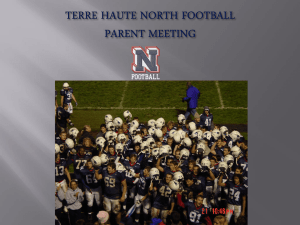
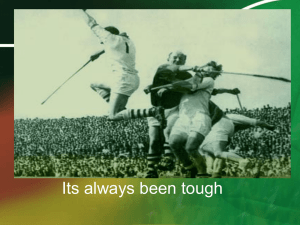
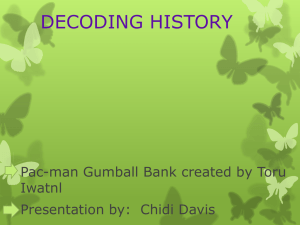


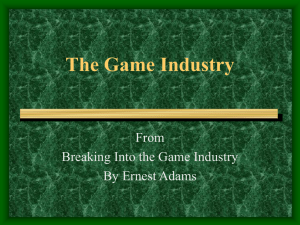

![Irish_Instruments[1]](http://s2.studylib.net/store/data/005225244_1-933d38d948219028b61a355ae6baf1c4-300x300.png)
